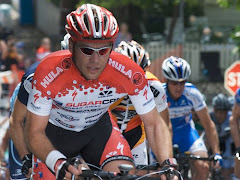Well you know how it's been raining, so on Saturday the 21st I went out and decided to make it short only an hour and a half and 22 miles. It actually had not rained on Saturday, but on Friday it had flooded.
I'm coming down this hill doing 34 mph (55KPH?!) and I'm fine I come out of the intersection at the bottom of the hill fine and trying to avoid some traffic. I get to the next light and I must have really been torquing the bike to keep up the speed because all of a sudden my front wheel starts to slip out from under me so I react, but overcorrect to the left in the direction of the slide, so then I react again the other direction and again overcorrect and boom boom I hit the pavement and end up sliding up on the sidewalk. The bike has a couple of scratches, my helmet cracked, but no sign of impact. My body on the other hand, four inch strawberry on left quad, 5-6 inch strawberry going from left shin to calf, I wrenched my thumb ( my hand was very swollen and some kind of muscle injury in my left ankle.
Went back there this passed Saturday the 28th (First day without rain since last Saturday the 21st) and looked at the area where all this happened. There's a puddle about 100 yards before all this happened and a wear pattern in the asphalt where it all happened. I'm guessing the asphalt was holding some water from the day before and the less than 1 inch tires just couldn't hold traction.
Lately on rainy days I run my tires about 5 lbs less than max for improved traction and it looks like I will need to do 10 in order to avoid this again. I'm still taking my glucosamine to help heal the soft tissue and such and taking aleve for the discomfort and daily activities' jarring. Well, K there's the whole story, this all happened about ten miles in to the ride and rode home with my @$$ hanging out like some of the racers on the tour, found a place that had a waterhose and hosed off the strawberrys and went on home. I've spent over four weeks injured this summer and this week is supposed to be Peak #2, but no dice, best I can do is toodle along at 12 MPH. I'm going to see if it improves today with the addition of my aero bars.
Monday, July 30, 2007
Tuesday, July 10, 2007
Resting Heart Rate
Training is going well, speed is increasing and my resting heart rate is going down! Both of these are signs of improved training effect.
Two weeks ago, the best I could do was 60 which in itself is not bad so I didn't lose that much training effect in the three weeks that I was off because of the accident.
Last week the best I could do was 53 which is a marked improvement. This is after a huge week of 160 plus miles. This past weekend the best I could do was 60 again. Obviously after a week of 160 miles then another of 100 plus I overtrained which is expected after a three week layoff.
Resting Heart Rate is your heart rate first thing in the morning before you even stretch while in bed. You count the beats for one minute. You can also count the beats in 10 seconds and multiply by 6 or count for seconds and multiply by 10. I feel you get better results with the minute count rather than either of the seconds.
Why is this important? If you look up at Heartzones by Sally Edwards, one of the pioneers of research and application of Heart Rate Monitor training you'll find that you resting heart rate number is very important in using the Karvonen Formula. The Karvonen Formula helps you find your percentages for training.
Two weeks ago, the best I could do was 60 which in itself is not bad so I didn't lose that much training effect in the three weeks that I was off because of the accident.
Last week the best I could do was 53 which is a marked improvement. This is after a huge week of 160 plus miles. This past weekend the best I could do was 60 again. Obviously after a week of 160 miles then another of 100 plus I overtrained which is expected after a three week layoff.
Resting Heart Rate is your heart rate first thing in the morning before you even stretch while in bed. You count the beats for one minute. You can also count the beats in 10 seconds and multiply by 6 or count for seconds and multiply by 10. I feel you get better results with the minute count rather than either of the seconds.
Why is this important? If you look up at Heartzones by Sally Edwards, one of the pioneers of research and application of Heart Rate Monitor training you'll find that you resting heart rate number is very important in using the Karvonen Formula. The Karvonen Formula helps you find your percentages for training.
Friday, July 06, 2007
New New
Hey, I got a new top speed for the season yesterday as an average on a ride. I looked down after a spurt and we had done 16.8 yee haw. Feels good to be improving. Lots of miles last week 160 something.
Subscribe to:
Comments (Atom)




